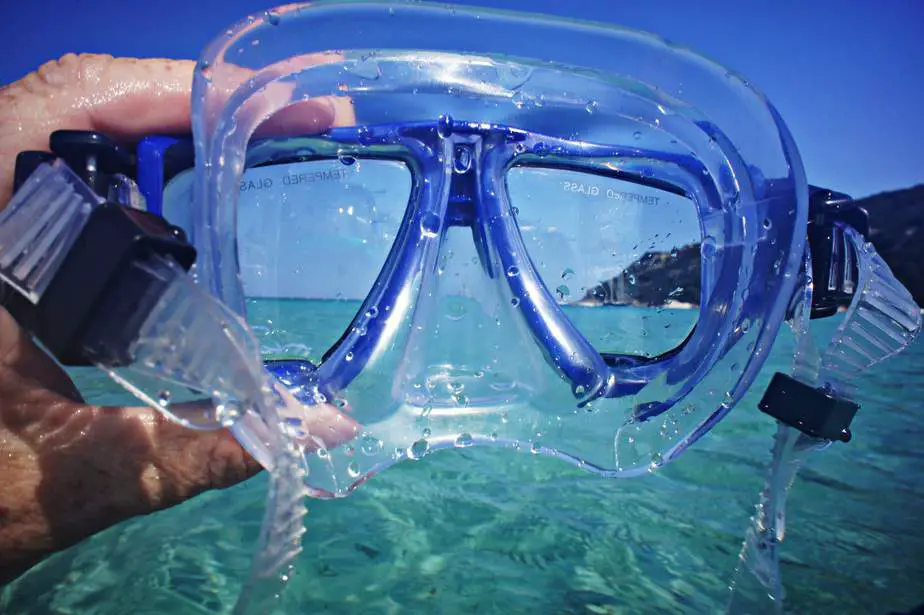If you’re new to snorkeling, you’re probably wondering how a snorkel mask works. This question might seem a bit silly to the more advanced snorkelers, but everybody has to start somewhere and it’s actually a very good question.
With the popularity of the full-face snorkel mask, there is now a very curious looking mask that some people are wondering how it works. We often see curious onlookers staring at people who wear full-face masks like they’ve just discovered a new animal species.
After all, aren’t the mask and snorkel supposed to be separate items? Why is there a snorkel sticking out from the top of the mask? Are all snorkel masks supposed to come with a snorkel built-in?
In this guide, we’re going to go over all the details regarding how a snorkel mask works. Whether it is a full-face mask or a traditional snorkel mask, you’ll learn how to select the best one and how to use it properly.
Snorkel Mask Functionality
To understand how a mask works, you have to first understand what it is designed to do. Snorkel masks allow you to safely and comfortably submerge your face underwater while swimming along the water’s surface and enjoying the beautiful views beneath the surface.
They are used in conjunction with a snorkel so that you can have a continuous supply of fresh oxygen without needing to surface. With a traditional snorkel mask, the snorkel is attached to the mask using a mask clip.
The type of snorkel you select is up to you. To use it, you must place your mouth on the mouthpiece of the snorkel and bite down on the bite tab to keep it in place before safely breathing through it.
Using a Full-Face Snorkel Mask
With a full-face snorkeling mask, the snorkel is built into the mask itself and you can breathe freely with either your mouth or nose. Many beginners enjoy the freedom this provides since it is intuitive and allows one to snorkel without having to keep something in their mouth the entire time.
Inexperienced snorkelers are often afraid of water leaks, whether it is water leaking into the mask or water entering through the snorkel, causing a choking hazard. In either case, it will end with you having to quickly resurface to fix it, ruining any immersion and enjoyment you were having.
For this reason, we recommend beginners start off with a full-face mask. Using one, you don’t have to worry about buying a snorkel separately, whether it will attach securely on the mask, or if the mouthpiece is comfortable to use. You will be able to naturally breathe through your mouth or nose and you don’t have to worry as much about leaking.
With a full face mask, there is more surface area for the silicone skirt to create a watertight seal on your face. Additionally, full face masks have built-in dry snorkels that will keep water out even if you fully submerge yourself underwater.
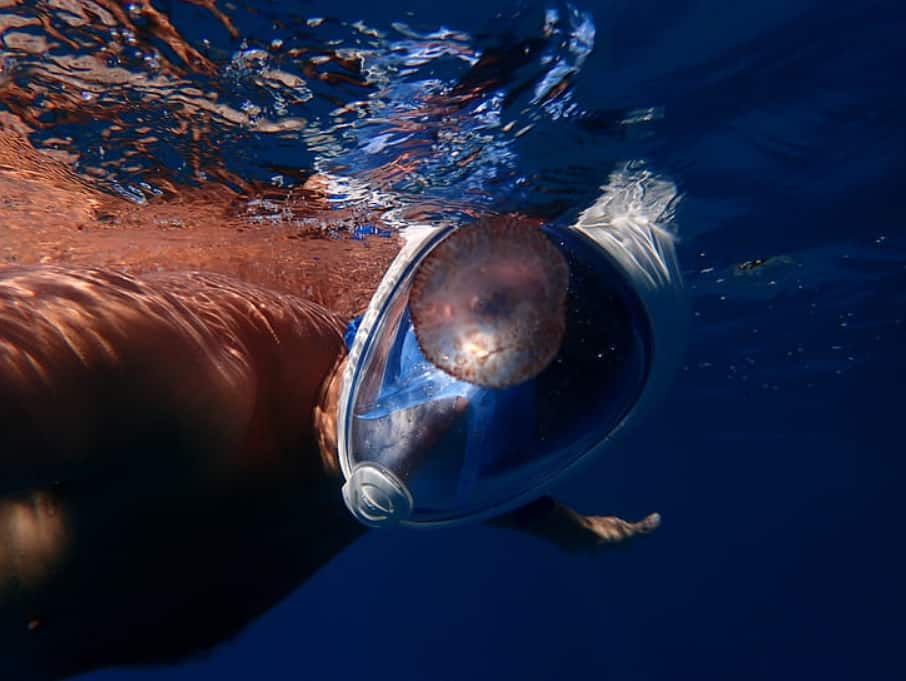
Marketed as using “dry top” technology, the snorkel found on full face masks share the same mechanisms that other dry snorkels have. It relies on a buoyant material attached to a flap which detects the water level. As the water approaches the top of the snorkel, the buoyant material rises and seals the opening, preventing water from entering.
Conversely, once the water level has dropped, the buoyant material will also lower and allow air to flow in once again. This process is automatic, meaning you can just focus entirely on snorkeling and letting the dry top technology work its magic without your input. This takes a load of stress off of beginner’s shoulders, allowing them to dive right in and snorkel immediately.
As effective as dry snorkels are, sometimes water will still occasionally seep in. Thankfully, most full face masks also feature a purge valve. Generally located beneath the mask, the valve will vent out any water that accumulates at the bottom of the mask.
Water should not be entering as long as the mask seals tightly on your face. When it comes to full face masks, there aren’t too many sizing options to choose from. There is usually the regular version and perhaps a smaller version for people with narrow faces.
Lastly, full face masks are often designed with airflow chambers that reduce the likelihood of masks fogging up. These chambers work by redirecting the flow of the moist air that you exhale away from the viewport, leaving your vision unobstructed. For more information on full face masks, read this article for a comprehensive review and buying guide.
Find A Snorkel Mask that Fits
In order for a snorkel mask to work it must first fit on your face comfortably. The mask is useless if water keeps entering or it is so uncomfortable you can’t stand wearing it for more than a few minutes. Here’s how to get a mask that you can rely on.
Do you see the rubber-like portion of the mask that presses against your face when worn? That is the skirt and it is responsible for creating a watertight seal on your face. An improper seal will result in leaking, fogging, and fatigue.
If you notice a leak, no matter how small, it means that at some point you will have to tread water and clear your mask. This wastes time and energy and takes away from your snorkeling experience.
To make matters worse, removing the mask to clear the water introduces moisture into the mask which can lead to fogging. The reason for this is that the fresh, moist air is a different temperature and condenses against the cold lens surface inside. In an ideal world, your mask will seal tightly so you won’t get leaks and you get to keep your mask on the entire time.
Never get a mask just because it looks cool, or because some pushy salesman is promising that the mask has some groundbreaking, innovative technology at unbelievably low prices. None of that matters if the mask doesn’t fit your face properly.
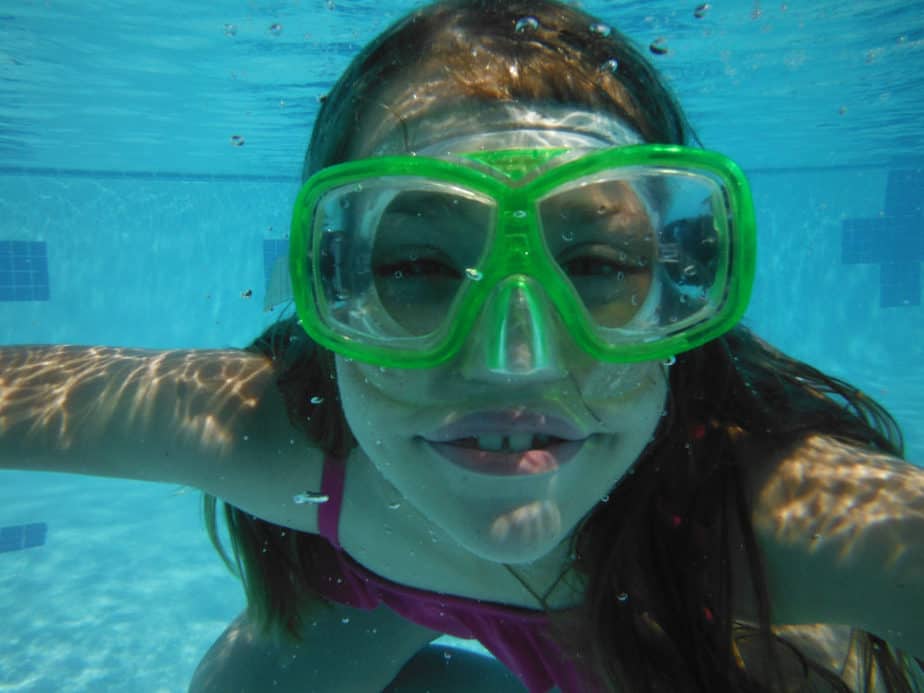
Testing The Snorkel Mask Fit
You want to get yourself a mask that is so comfortable you will forget you are even wearing a mask while snorkeling. That way, you can focus entirely on enjoying your vacation, not fidgeting with a leaky mask. This is easier said than done because everybody’s facial structure and size is different. Here’s how to test a mask to determine how it fits your face.
- Place the mask to your face and gently hold it in place. Hold your breath; we don’t want any breathing to affect this test.
- Take your hand off the mask and see if it remains on your face. You should still be holding your breath. Almost any mask will stay on your face if you’re inhaling with your nose hard enough, so take this uncertainty out of the equation by continuing to hold your breath.
Even without using straps or inhaling with your nose, the mask should stay on your face. From this simple test you can get a good idea of how well the mask seals, which means a lower likelihood of any water leaks when you’re snorkeling.
If the mask falls off without support from your hand, then the seal is not strong enough. You can quickly move on to the next mask. No matter how attractive a mask is based on its appearance or price, if it doesn’t pass this simple test then you should move on.
Comfort
Once you’ve found a mask that meets the very important criteria of sealing tightly against your face, the next step is to find a comfortable mask. Oftentimes a watertight mask and a comfortable mask are one and the same.
After all, a well-fitting mask means you don’t have to wear the mask strap so tight in order to keep water out. The mask strap is usually the culprit in an uncomfortable mask. You should only have to tighten it enough so that the snorkel mask is secure and doesn’t shift whenever you turn your head.
Don’t rely on the strap to keep the snorkel mask on your face. Remember the simple test above? The mask must be capable of sticking on your face on its own.
One common reason for a mask to leak is not necessarily due to the mask’s fault. Any rogue strands of hair from your head, or facial hair in the case of men, can make it difficult to seal the mask on your face. You should shave off any facial hair and tie your hair back if it is getting in the way.
An easy way to do this is to wet your hair and then push it to the back of your head. Also before pressing the skirt on your skin, run your finger along the edge to get any hair out of the way. You can also get extra sealing power using a mask sealant or silicone grease.
Read our guide on snorkeling with facial hair to learn more ways to create a watertight seal with your mask.
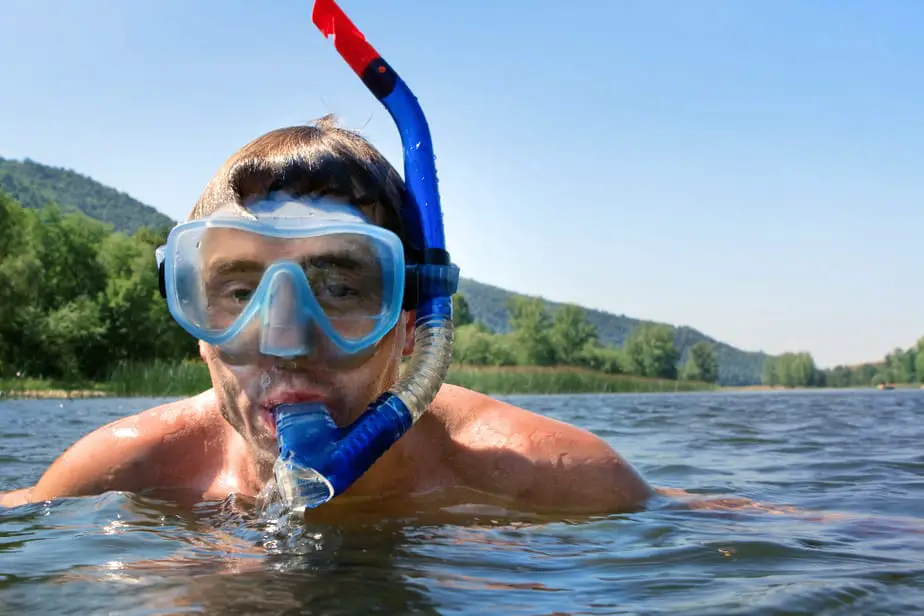
What to Look For in a Snorkel Mask
In this section, we are going to cover what other factors you should consider in a snorkel mask beyond just looking for a mask that fits. Perhaps you may find multiple masks that fit you, so what other features might you want to look for? Keep in mind, all of the factors below are still secondary to finding a mask that seals tightly on your face.
Wide Skirt
Remember that the mask skirt is what’s actually going to seal on your face. When shopping for a mask, you want to make sure that skirt is high-quality. Since it will be pressed against your face the entire time you’re snorkeling, it should be comfortable enough that you barely even notice it’s on your face.
Next, you will notice that skirt widths will vary between masks. A general rule of thumb is the wider the skirt, the more skin surface area it will be in contact with, resulting in a tighter seal.
Materials
The materials the mask is constructed from will affect its durability and comfort. We recommend looking for a mask with a silicone skirt. Rubber skirts are brittle and will eventually crack. On the other hand, masks made from silicone will withstand rigorous use for years.
Peripheral Visibility
When snorkeling, it is not wise to be turning your head in the direction you want to look. This will affect the position of the snorkel, which you always want to be pointing up. Instead, you should keep your head still and look by moving your eyes.
This is why the peripheral visibility of your mask is important. What that means is that there should be minimal obstructions to your peripheral vision (what you see on the edge of your vision). Some masks have lenses that only point forward, making you feel perhaps claustrophobic or tunnel-visioned.
To prevent this, some higher quality masks have side lenses, or have one main continuous lens so there are fewer components obstructing your vision. The best masks should make you feel like you’re staring through a panoramic window. If you can, get a mask with a wide view.
Anti-Fog Lens
This is a bit of a misnomer, as no lenses can be truly immune to fogging up and they all require some preparation on your part. However, you can think of anti-fog lenses not as “no fog” masks, but more like “low fog” masks. In other words, you may not need to do as much work to keep your mask free and clear of fog while snorkeling.
Vision Enhancing Coating
Some masks are designed to help you see better in low-light conditions while snorkeling or diving. No, the mask doesn’t come with night vision like you’re a secret agent. However, the lens may be coated with a special tint that sharpens the image by reducing the glare and filtering some wavelengths of light, making the image crisper and clearer.
These masks do work, but at the same time don’t expect miracles to happen. If the mask doesn’t have special lenses like these, don’t worry too much about it but it is worth mentioning.
Prescription Lenses
Similarly, glasses wearers can safely snorkel by getting a mask with prescription lenses. Of course, using a regular mask with contact lenses is a viable option. But if you don’t want to worry about your contact lenses falling out, know that there are prescription lenses.
Prescription lenses are understandably pricier than a mask with regular lenses. There are a few ways to order them.
First, you can buy masks with corrective lenses already installed in them. Some companies boast an impressive range of corrective lens ranges, from a negative dipper range of -1.0 to -10.0, to positive ranges of +1.0 to +4.0 in increments of 0.5. Of course, you can select different ranges for each eye. If you already know your prescription, ordering online is very easy.
If you already have a mask that you like, you can get bespoke lenses with the correct prescription installed onto your preferred mask. You will have to ask the dive shop to help with this custom order, since the lenses are custom made and need to perfectly fit your mask.
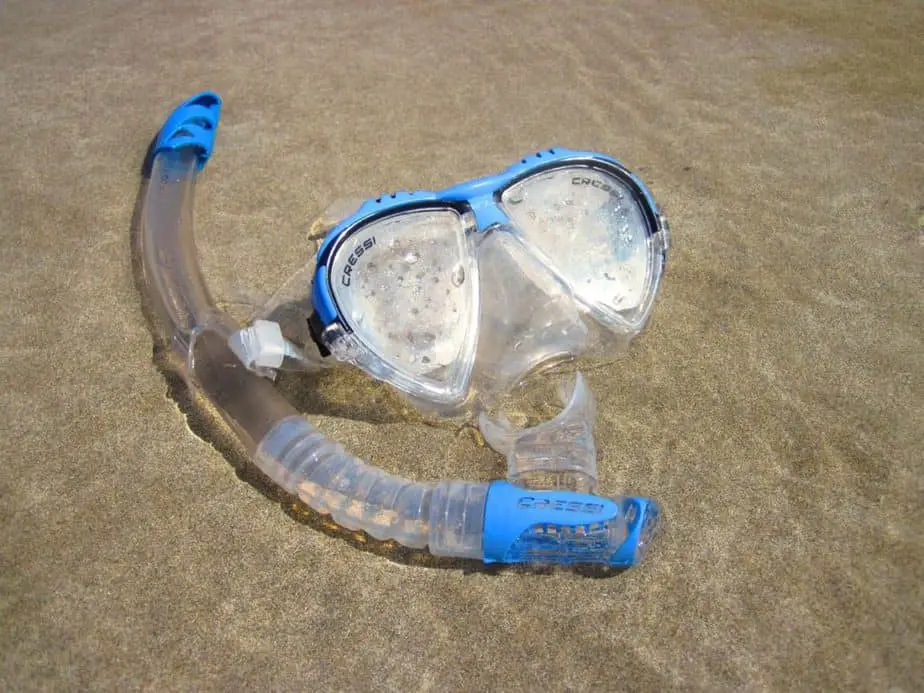
Next, you can get bonded lenses, which are essentially lenses that are glued onto your regular mask lens. This won’t perfectly cover your mask and there will be some gaps which might irk some people.
You can also get drop-in lenses that allow you to swap lenses out of your mask quickly. This can be tricky if you don’t know what you’re doing, as you can easily damage the mask when trying to swap the lenses.
Lastly, for those who are near-sighted, you can also glue magnifier lenses onto your mask lens. These turn your lenses into bifocals, allowing you to look down at the magnifier lens to get a clearer reading of any gauges or camera screens. The magnifiers are small and should not obstruct your viewport.
Low Volume
Should you ever decide to dive down to get a closer look at coral or fish, you will notice the water pressure causing the mask to squeeze tightly on your face. This can feel painful unless you exhale through your nose to equalize the pressure. The deeper you dive the greater the pressure, and the more you must exhale to fill the mask.
One of the reasons why we recommend getting a mask with low volume is to make it easier to equalize the pressure. Low volume masks, as the name suggests, have less space for air to fill up meaning the lens will be closer to your eyes. With less volume, you do not have to exhale as much to manage the pressure.
Furthermore, since the lenses are closer to your eyes, there will be less mask material to obstruct your peripheral vision. In other words, you can keep precious air in your lungs and get a better view with a low volume mask. It will also reduce the chances of fogging, since you will be introducing less moisture by not exhaling as much. Neat, huh?
How to Keep Your Mask from Fogging
A foggy mask can make it difficult for you to enjoy your snorkeling experience. The fog obstructs your vision which not only takes away from your enjoyment but can be hazardous if you are struggling to see where you are going. Having to stop snorkeling every few minutes to tread water and get rid of the fog wastes time and energy.
Therefore, you should be doing everything in your power to keep your mask from fogging up. The reason a mask fogs is due to a difference in temperature as well as introducing moisture. Mentioned above, each time you exhale through your nose to equalize the pressure you are introducing moisture. Also, each time you remove your mask you are also introducing moisture.
In fact, even if you don’t take off your mask, but if you surface and expose your mask to direct sunlight for too long, that can increase the temperature and cause condensation to occur on the lens. The general rule of thumb is to try not to exhale too much through your nose, try not to take off your snorkel mask unless absolutely necessary, and if you surface, don’t spend too long in the sun.
As for preparations you can do beforehand, make sure to get rid of the layer of silicone in new masks and to apply anti-fog or a mixture of baby shampoo with water to treat the mask. Be careful if your mask has plastic lenses, since burning the mask or cleaning it with toothpaste applies only to masks with glass lenses.
Also, make sure not to let your fingertips touch the lens since trace amounts of oil can transfer to it.
Can You Snorkel with Swim Goggles Instead?
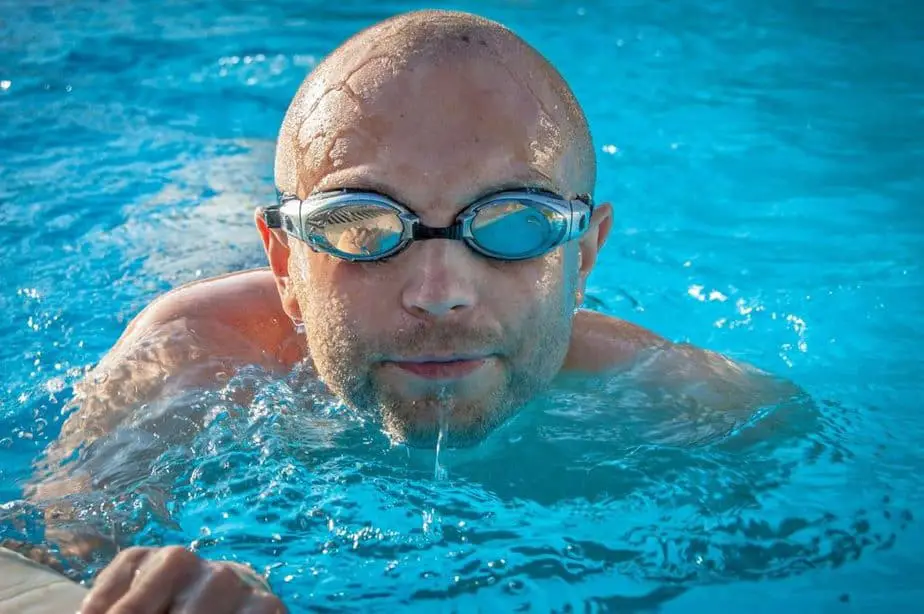
Snorkel masks and swim goggles are NOT the same thing. Both are designed for different purposes, and trying to substitute one for the other will produce lackluster results.
Almost everyone has a pair of swim goggles lying around somewhere, but not everyone has a snorkel mask. You should not use them interchangeably since they excel in different areas. A pair of swim goggles will cause trouble for you if you try to snorkel with it and vice versa.
For one, it’s simply not practical. Snorkel masks are designed such that snorkels can attach to it with a mask attachment. Snorkels cannot reliably attach to swim goggles which makes it hard for you to keep the snorkel in your mouth.
Furthermore, if you intend to dive at all, then you will realize that you cannot equalize the pressure in swim goggles unless you are wearing a snorkel or dive mask. The reasons for this is that snorkel masks also cover your nose, which allows you to exhale to equalize the pressure in the mask.
Without the ability to equalize the pressure, swim goggles will squeeze against your eyeballs which is painful and can harm your eyes. In addition, swim goggles are made with less durable materials and may not withstand the water pressure.
Conversely, you shouldn’t be competitively swimming or training with a snorkel mask either. Snorkel masks are bulkier and will increase drag. Swimming goggles are designed to be slim in order to reduce drag.
In conclusion, you should use the correct equipment for the sport. Furthermore, it’s not like either a pair of swim goggles or a snorkel mask is particularly expensive, so we recommend you get a snorkel mask if you want to enjoy snorkeling without issues.
Learn more about the differences between swim goggles and snorkel masks here.
How to Clean Your Snorkel Mask
If you want your equipment to last for years and years, you need to learn how to take care of them. You should clean your mask each time you use it and let it fully dry before storing it.
Depending on the type of mask, the cleaning process will be slightly different. After snorkeling, rinse it with freshwater to get rid of any saltwater. You want to do at least this much before taking it back to the hotel to do a more thorough clean.
If you have a mask with glass lenses, you can scrub the mask with a toothbrush and toothpaste. Take care not to let your finger touch anything since the oils on your hand can transfer onto the lens.
For masks with plastic lenses, use dish soap and a soft brush or cloth to clean the lens. The abrasives from the toothpaste and the hard bristles from the brush can scratch brittle plastic lenses. Full face masks tend to have plastic lenses, so take great care not to damage it when cleaning it.
Finally, rinse the bubbles off with freshwater once again and dry it with a towel. Leave out to air dry (in the shade in a well-ventilated area, out of direct sunlight) before storing it.
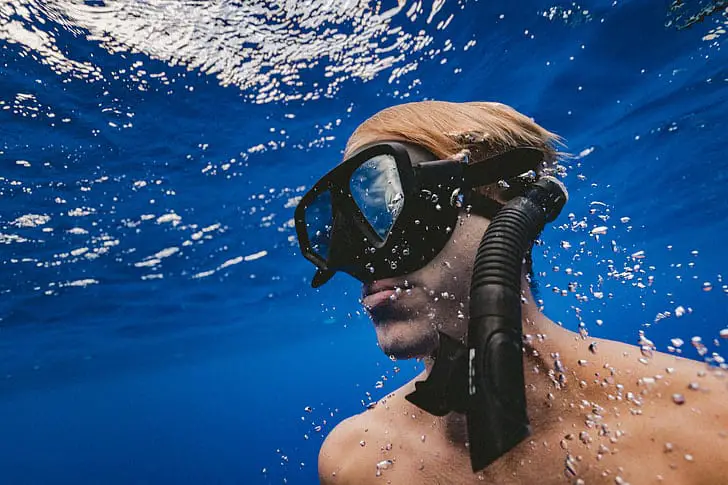
Should I Use a Full Face Mask or Traditional Snorkel Mask?
Full face masks are a great tool for beginners since it is a complete package. It removes the need for one to do so much market research, meticulously examining all of the various masks and snorkels available. Since full face masks come with a dry snorkel built into it, beginners can basically get started with snorkeling right away.
Additionally, full face masks allow one to breathe with either their mouth or nose. In other words, you do not have to bite down on a snorkel mouthpiece which some find very liberating. Full face masks have built-in purge valves to clear out any water that seeps in and is designed to be fog-free. With all of these features, it’s no wonder that so many beginners love it, though it is expensive.
On the other hand, traditional masks and snorkels have a significantly wider selection. With so many options available, you have a better chance of finding a mask and snorkel that is more comfortable and seals tightly. Snorkel masks can be fitted with prescription lenses, though you could just wear contact lenses for either mask.
Depending on how much effort you are willing to put in when shopping for your mask and snorkel, you could find a combination that is cheaper, fits better, and is more comfortable than a generic full face mask. However, time is money and effort is exhausting, so by paying a premium beginners can avoid the trial and error when mask shopping by opting for a full face mask instead.
How Does a Snorkel Mask Work Recap
Snorkel masks are pretty easy to understand once you know their purpose and how they are meant to to be used. When snorkeling, you want to wear a mask to protect your eyes from anything unpleasant that might be floating in the water. The mask provides a barrier that keeps water and debris away from your eyes while providing a wide angle for you to see the underwater sights.
Additionally, the snorkel mask is where you can attach the second essential snorkeling item, the snorkel, which lets you breathe along the surface of the water. The mask and snorkel are two items that must always be used together, and in the case of a full face mask they are literally combined into one product.
In order for a snorkel mask to be effective, it must fit your face properly. The silicone skirt of the mask must be able to create a watertight seal on your face to prevent water leaks. A tight seal will also reduce the chances of the mask fogging up. You can tell if a mask fits you well if it can stay on your face even without a strap on.
If you want your snorkeling experience to be smooth and hassle-free, make sure to get yourself a high-quality snorkel mask that fits comfortably on your face and seals properly.
You might also be interested in our articles on how does snorkeling work and how do snorkels work.

